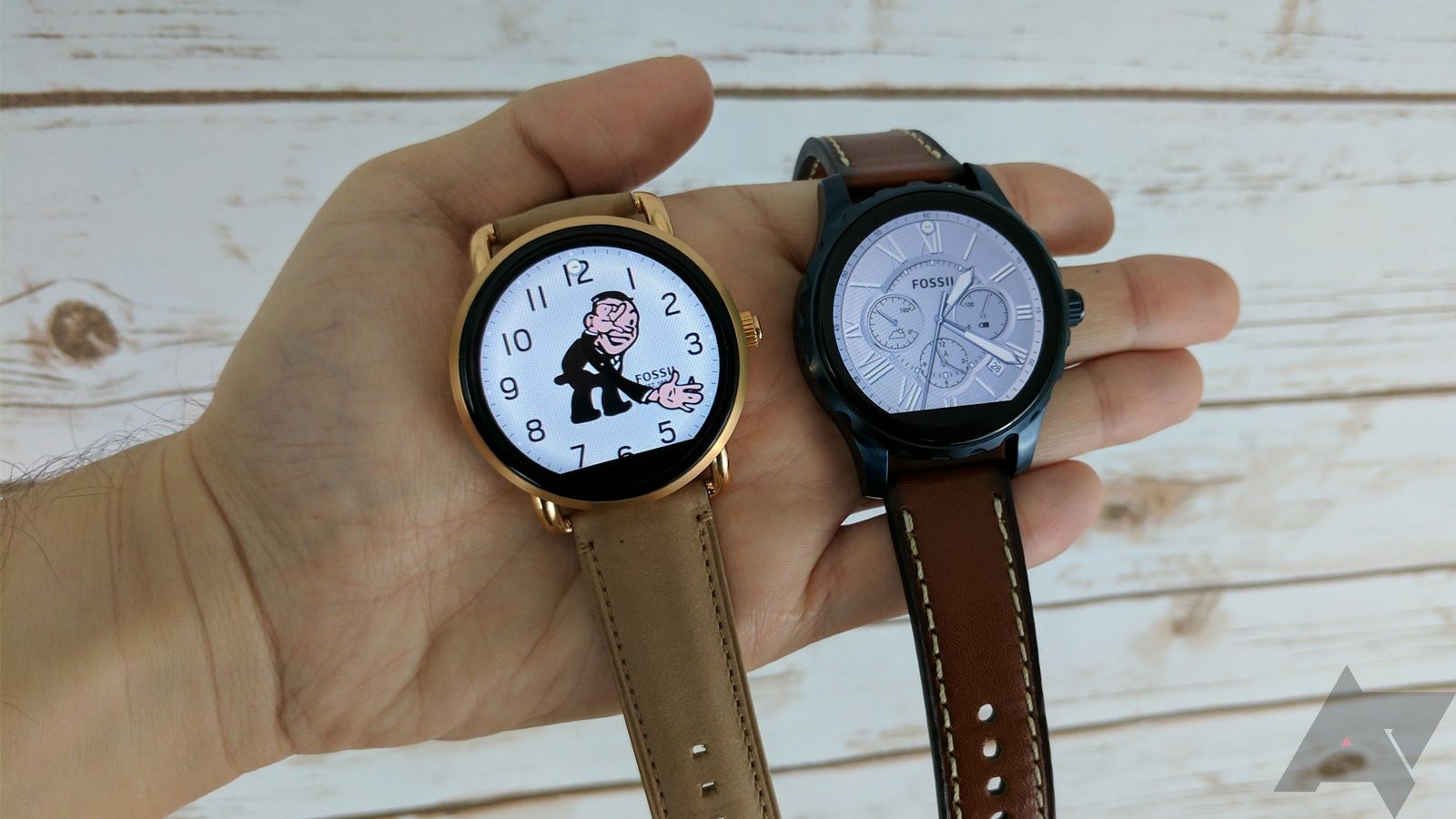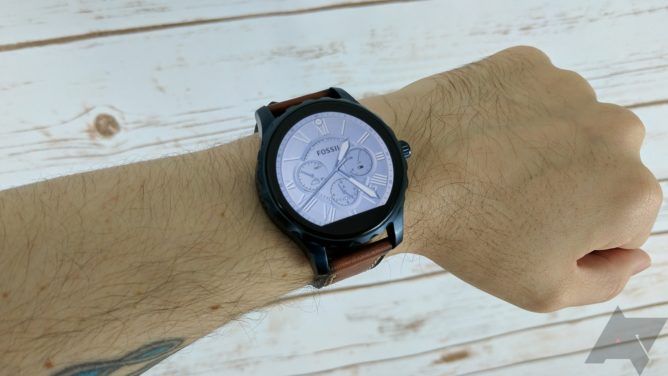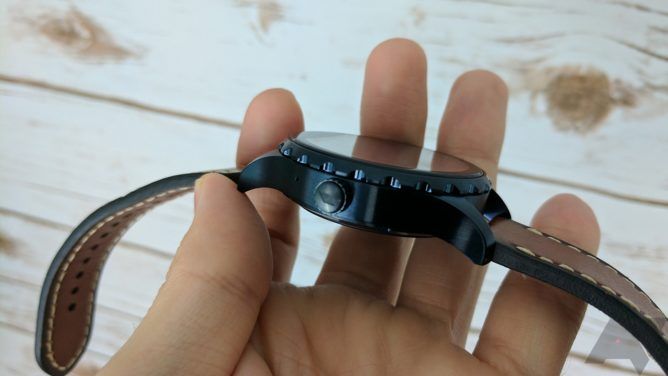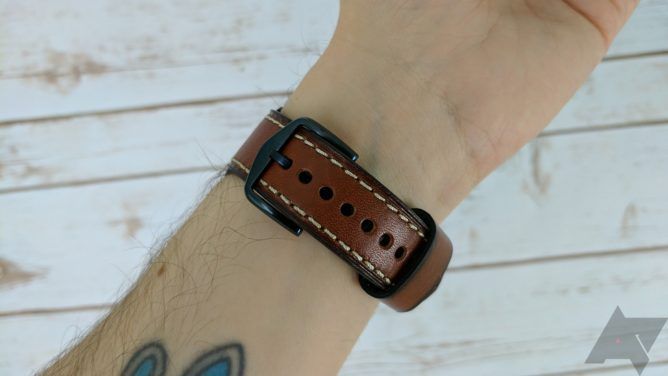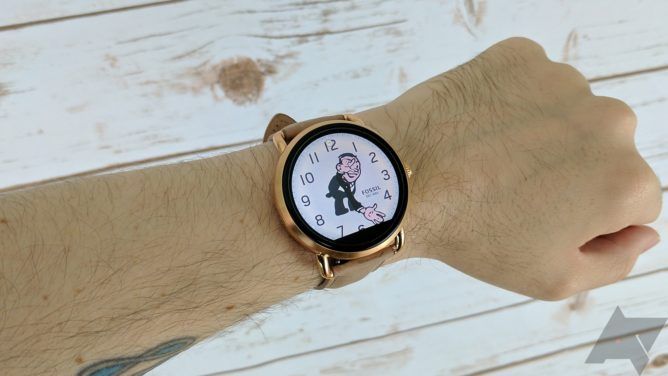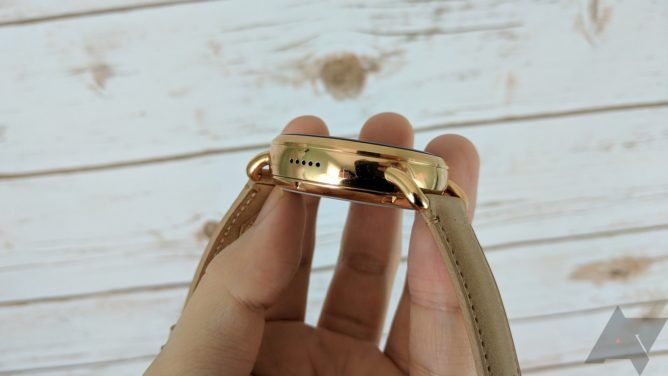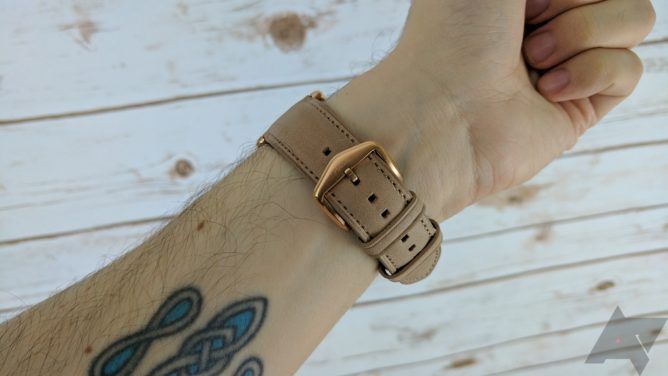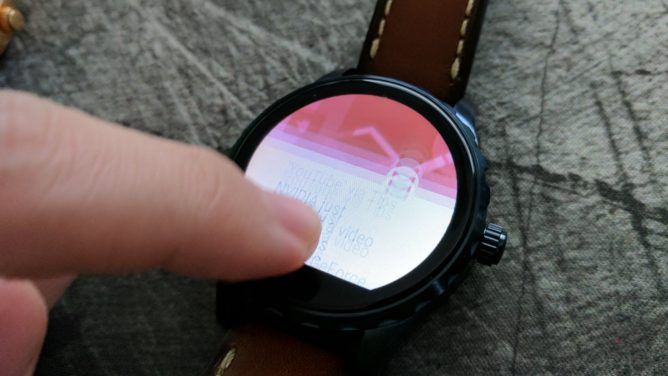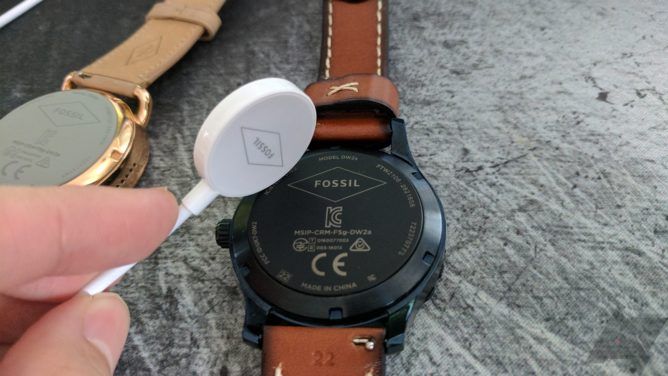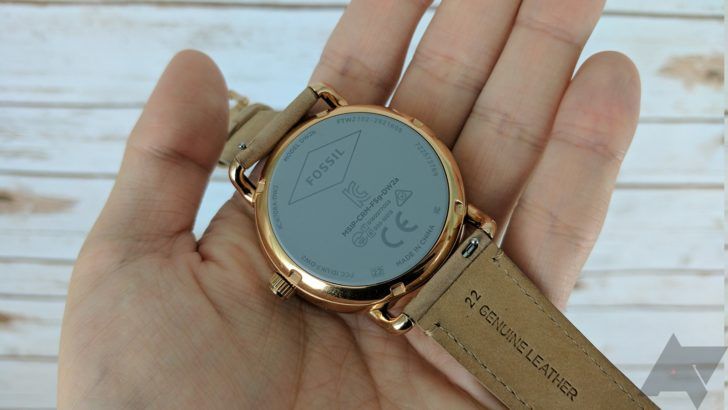Quick Links
Everyone was intrigued when Fossil announced it would make Android Wear devices. After all, it makes "real" watches, so maybe its smartwatches would be a cut above. The Q Founder was an okay smartwatch for its time. It was a little big, but it looked nice and had a fast Intel SoC. Now, Fossil is back with the Q Marshal and Q Wander. These smartwatches are some of the first to have the wearable-focused Snapdragon 2100 chip, but is that enough to make them a good purchase? Sadly, not really.
SPECS
|
SoC |
Snapdragon 2100 |
|
RAM |
512MB |
|
Storage |
4GB |
|
Display |
1.42-inch 320x290 |
|
Battery |
360mAh |
|
Protection |
IP67 |
|
Software |
Android Wear 1.5 |
|
Measurements |
45mm x 14mm (13.5mm for Wander) |
THE GOOD
|
Design |
The Q Marshal has a "real" watch look and both watches fit well. |
|
Bands |
Fossil's included bands are better than most. |
|
Battery |
Slightly better battery life than past watches. |
THE NOT SO GOOD
|
Display |
These watches have awful LCDs with poor viewing angles, dull colors, and lots of ghosting. Flat tires too. |
|
Design again |
The Q Wander is not very attractive in person. The crown buttons are also stiff and have too much travel on both. |
|
Light sensor |
There isn't one. |
|
Heart rate sensor |
Doesn't have one of these either. |
|
Android Wear |
It's still Android Wear, which is in need of an update. When these watches will get v2.0 is anyone's guess. |
|
Price |
At around $250, these watches are too expensive for what you get. |
Design
While many of the specs are the same between the Q Wander and Q Marshal, the external designs are different. So, I'm going to break this section out into one for each watch. We'll link up again on the other side.
Q Marshal
Like the Q Founder, the Marshal adopts a very traditional watch design vibe. The body is a little more compact than the Founder, though. It's 45mm across, so it's still on the large side for a watch (smart or otherwise). The metal frame morphs smoothly into the prominent exposed lugs, which accommodate a standard 22mm watch band. The lugs curve down slightly toward the bottom side of the watch. This is a design feature I like to see as it keeps the band closer to my arm for a more comfortable fit.
The face of the watch has the flat tire display, of course. Surrounding that is a ring with "teeth" that give it a cool visual flair. It's the same thing Samsung did with the shape of the Gear S3 and Motorola with the knurl pattern on the Moto 360 v2. On the right of the case is a single physical button right in the middle at the 3 o'clock position. I'm actually not in love with this button—it has a satisfying click when depressed, but there's a ton of travel and the action is stiff. On the opposite side is a speaker grille, which performs fine. It's a speaker in a watch, so don't go in expecting anything amazing.
On the bottom is just a flat plastic cover. No heart rate measurements are happening here. That's kind of lame for the price, but the Q Founder didn't have one either. The version I have for review has a standard Fossil thick leather band. These are actually quite nice for a mainstream watch band. It's a little heavy for someone with thin wrists, but I can't complain too much. Metal link versions are available too.
The Q Marshal could easily be mistaken for a real watch at a glance, which I think is what you want. It's a little larger than I'd prefer, but I have tiny little bird wrists.
Q Wander
The Wander has a much more unusual external design, but it's clearly related closely to the Q Marshal. It too has a 45mm case, but the shape is much more rounded than the Marshal. Frankly, this makes it look thicker, but it's actually a fraction of a millimeter thinner.
I often find myself saying that a device looks nicer in person than it does in photos, but I think it's the other way around for the Q Wander. It's not the best looking smartwatch I've seen. If there's anything Fossil should be good at, it's designing an attractive case for all the smart stuff to go in. It's the lugs that take the watch from boring to a little goofy looking. They just sort of appear in the side of the case. There's no gentle transition or embellishment that helps them blend in. They're just round pegs that jut out.
Despite being a less attractive watch overall, I think the Q Wander fits slightly better than the Marshal. The lugs don't extend as far outward, but they still tilt downward to keep the band close to your wrist. Like the Marshal, it uses a standard 22mm band. This review units has a thinner tan leather band with a softer finish. It gives the watch a somewhat feminine look, in my opinion. It seems like a good quality band, but it'll crease easily as it's so soft.
Again, there's a speaker on the left side and a crown button on the right. The button is the same as the Q Marshal—so, not my favorite, but passable. It has the same plastic underside with no heart rate sensor.
Display
Things are probably sounding at least alright so far, right? What could go wrong? This: there's no ambient light sensor. These are far from the first Android Wear devices to lack this feature, but they're the first I can think of that have a flat tire display and no light sensor in the cut off section. Some people are under the mistaken impression that the flat tire is entirely for the light sensor, but it's actually where the display drivers connect to a round LCD. It's just been traditional to put a light sensor there. The Founder had a light sensor, so I don't know why Fossil would remove it this time. The lack of a sensor means you have to control the brightness of your flat tire display manually. The display does get reasonably bright when you dig into the settings and change it, but the black levels are mediocre at best.
Let's be frank here—the flat tire is a compromise. Removing one of the only mitigating features makes me wonder why a device maker would go with a flat tire LCD at all. Surely round AMOLEDs are more accessible now. Maybe it's a cost issue, because seriously Fossil cheaped out on this display.
The viewing angles of the LCD used in the Marshal and Wander are terrible. When you get about 45-degrees off-axis, the colors begin to distort noticeably, making text very difficult to read. Compare this to something like the Moto 360 v2, which has an LCD that's readable at all angles. The colors even when you're looking straight at the display aren't very impressive. It's a very dull screen.
My biggest problem with this display is the absolutely unacceptable amount of ghosting. The refresh rate feels incredibly slow. Everything leaves a blurry after image for a moment that looks awful. It doesn't help that most of Android Wear's UI is composed of cards that slide across the screen. The ghosting is extremely obvious when you swipe those white cards across a colored background.
Performance and battery
I was interested to get a look at these watches because they're some of the first to have the Snapdragon 2100 SoC. This chip was announced earlier in 2016 as Qualcomm's big push for next-gen wearables. Rather than re-purposing a SD400, the 2100 has a smaller footprint, draws less power, and is better for collecting sensor data.
I wish I could tell you this is what we've been waiting for, and the Snapdragon 2100 will finally do away with smartwatch battery anxiety, but it's just a small step up. That's not to say the Snapdragon 2100 is a bad chip; quite on the contrary, I think it's better than all the previous chips we've seen in smartwatches. It just isn't enough.
With the Q Marshal and Wander, I'm seeing a little over 24 hours of battery life, which is solid in the context of existing smartwatches with always-on displays. It's a marginal improvement, but you will still have to charge the watch every night (assuming you want it to last all the way through the following day). I do really like the wireless charger Fossil has included with these watches. It's a small magnetic disk that attaches to the bottom of the device. The tiny Qi coil isn't picky about orientation or location, either. You can also use a standard Qi-based wireless charger to juice up the Q Wander and Q Marshal.
On the performance side, the Snapdragon 2100-powered watches don't feel dramatically different than older ones. These watches also have half the RAM of the Founder. That might be negatively impacting the SD2100, but I can't say for sure. It's hard to make a direct comparison. There's maybe a bit less lag in places, but Android Wear still isn't as responsive as I'd like.
Software
As you're probably aware, OEMs have very limited control over how Android Wear operates. They're restricted to some add-on apps and watch faces. Fossil's approach to Android Wear is interesting in that respect. I assumed before I used the Q Founder that Fossil would create some of the best watch faces, but they were actually rather disappointing. It's the same story this time.
These watches have flat tire displays—that's just something you have to live with, but Fossil seems to be in denial about it. Many of the pre-loaded Fossil watch faces have the bottom of the design cut off in a way that only draws attention to the missing pixels. For an example of how to work with a flat tire, look at Motorola's watch faces. Fossil didn't even change the watch faces from last year that cut off a giant portion of the "6." Where's the attention to detail, guys?
Likewise, Fossil didn't address the near useless widgets on its watch faces. The default one when you turn the device on has a battery gauge so tiny you can't tell the difference between 75% and 50%, a weather icon (not the temperature), and what appears to be a step counter. I'm not sure because it never shows anything other than a "%" symbol. The watch faces you can download in the Play Store are vastly better than Fossil's pre-loads.
That brings us to the Fossil Q Android app... or rather it doesn't. Fossil has decided to drop support for the Android Wear devices in this app, so it's only for fitness bands and smart "real" watches. All the watch's functions are controlled on the watch itself and via the Wear app. The app wasn't very useful last year, but managing watch face profiles in the wearable Fossil Q app is tedious.
Value and thoughts on Android Wear
The Q Founder and Q Marshal come in a few different configurations, all of them priced around $250. They are not good purchases at that price. There are too many problems with the hardware to justify that amount of money. The displays are bad, there's no light sensor, the buttons are too stiff, and the Wander is a rather ugly watch. If these were priced as entry-level wearables, sure, I might be able to recommend them.
Even if they were good, I'm not sure anyone should be buying an expensive new Android Wear device right now. Google had to push back the release of Android Wear 2.0 because it was a convoluted mess. We've also seen a number of device makers step back from the wearable market. There's no new Huawei Watch or Moto 360 this year, and those were arguably the most successful Wear devices of the last generation. We don't even know what's going to happen with updates to Wear 2.0. I assume Fossil doesn't employ a bunch of Android developers, so Google is likely calling the shots with regard to the software. Will there be enough bandwidth to get updates to these watches in a timely manner? I don't know, but do you want to stake $250 on it?
Smartwatch hardware has not advanced much since Wear was released more than two years ago. These are still devices that need to be charged every day, and they're too expensive for what they do. Even the best Wear devices of last year were too expensive for any non-nerds to justify. Huawei sold versions of the Hwatch that cost as much as a Google Pixel, and they weren't any better than the cheap ones; they just looked different.
If you really want an Android Wear device right now, the Huawei Watch and Moto 360 can be found for less if you shop around a little. Despite the older ARM chip, they offer a superior experience. Fossil's new watches aren't good, and if this is what a $250 smartwatch with a proper wearable SoC is like in 2016, I think Wear is in deep trouble.

